Nance–Horan syndrome
Nance–Horan syndrome is a rare X-linked dominant syndrome characterized by congenital cataracts leading to profound vision loss, characteristic dysmorphic features, and dental anomalies.[1][2] Microcornea, microphthalmia, and mild or moderate intellectual disability may accompany these features. Heterozygous females often manifest similarly but with less severe features than affected males.
| Nance–Horan syndrome | |
|---|---|
| Other names | Cataract X-linked with Hutchinsonian teeth |
 | |
| This condition is inherited in an X-linked dominant manner. | |
| Specialty | Ophthalmology |
Presentation
Dental features:[2]
- small teeth in males
- pointed (screwdriver shaped or conical) incisors (sometimes called Hutchinson teeth)
- incisors with an irregular incisal edge
- canines: enlarged and globular; may be dome or bud shaped with trilobed edge
- premolars and molars: small, round and globular; may have supernumary lobes (mulberry or lotus flower shape)
- widely separated teeth (diastemma)
- hypoplastic enamel
- dental agenesis
- presence of mesiodents (median incisor behind normal upper incisors)
- pulp chamber anomalies
Facial features:[2]
- anteverted pinnae
- long face
- prominent nasal bridge and nose
- prognathism occasionally
Ophthalmic features:
- bilateral congenital nuclear opacities (100%)
- severe amblyopia
- nystagmus (93%)
- strabismus (43%)
- microcornea (96%)
- congenital glaucoma
- scleral staphylomas
- retinal cystoid degeneration
- microphthalmia
These lead to severe visual impairment in affected males.
Other:[2]
- The fourth metacarpal may be shortened
30% of patients also have some degree of intellectual impairment: of these 80% are mildly to moderately affected: the other 20% may have developmental delays and behavior problems.
Carrier females display milder variable symptoms of disease. Ocular signs are present in 90% of heterozygous females. These are typically lens opacities often involving the posterior Y sutures. More rarely dental anomalies and the characteristic facial features may also occur.
Genetics
This syndrome is caused by mutations in the Nance Horan gene (NHS) which is located on the short arm of the X chromosome (Xp22.13).[3]
Diagnosis
Management
There is no known cure for this syndrome. Patients usually need ophthalmic surgery and may also need dental surgery. Genetic counseling and screening of the mother's relatives is recommended.
History
This syndrome was first described by Margaret B. Horan and Walter Elmore Nance in 1974.[4][5]
References
- Walpole, I R; Hockey, A; Nicoll, A (1990). "The Nance-Horan syndrome". Journal of Medical Genetics. 27 (10): 632–4. doi:10.1136/jmg.27.10.632. PMC 1017242. PMID 2246772.
- Bixler, D; Higgins, M; Hartsfield Jr, J (1984). "The Nance-Horan syndrome: A rare X-linked ocular-dental trait with expression in heterozygous females". Clinical Genetics. 26 (1): 30–5. doi:10.1111/j.1399-0004.1984.tb00783.x. PMID 6467651. S2CID 32897580.
- Tug, Esra; Dilek, Nihal F.; Javadiyan, Shahrbanou; Burdon, Kathryn P.; Percin, Ferda E. (2013). "A Turkish family with Nance-Horan syndrome due to a novel mutation". Gene. 525 (1): 141–145. doi:10.1016/j.gene.2013.03.094. PMID 23566852.
- Horan, Margaret B.; Billson, F. A. (1974). "X-Linked Cataract and Hutchinsonian Teeth". Journal of Paediatrics and Child Health. 10 (2): 98–102. doi:10.1111/j.1440-1754.1974.tb01098.x. S2CID 71936293.
- Nance, WE; Warburg, M; Bixler, D; Helveston, EM (1974). "Congenital X-linked cataract, dental anomalies and brachymetacarpalia". Birth Defects Original Article Series. 10 (4): 285–91. PMID 4470901.